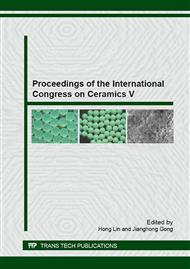p.11
p.17
p.22
p.27
p.32
p.36
p.41
p.45
p.49
The Influence of Sintering Temperature on Properties of Silicon Carbide Porous Ceramic Filter Membrane
Abstract:
The average particle size of SiC used as raw materials is 60 μm, the filter membrane in a mass ratio of each component are: SiC : binder: sodium carboxymethyl cellulose (CMC): deionized water =9:1:1:20. Method of producing membrane by means of spin coating, the sintering temperature was set in different ranges. The Archimedes drainage method was used to measure its porosity, and the filter pressure of membrane was charactered by the filter pressure testing system, SEM was performed to characterize its surface morphology and microstructure. The results show that: when the temperature rises from 1225 °C to 1325 °C, the filter pressure of SiC porous ceramic filter membrane decrease firstly and then increase; the atlas trend of the porosity is roughly opposite with the filter pressure, the maximum of the porosity value is about 42% when the temperature reaches 1300°C, at this temperature, the filter pressure reaches a minimum value and the surface of the filtration membrane is the most flat. When the temperature reaches 1350 °C, the surface of the film started showing a plaque.
Info:
Periodical:
Pages:
32-35
Citation:
Online since:
July 2015
Authors:
Price:
Сopyright:
© 2015 Trans Tech Publications Ltd. All Rights Reserved
Share:
Citation:


